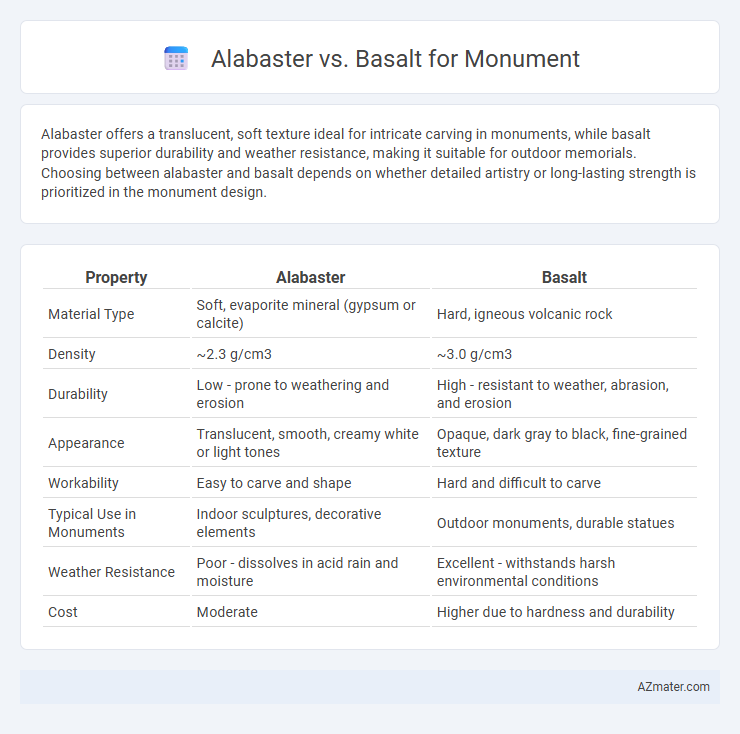Alabaster offers a translucent, soft texture ideal for intricate carving in monuments, while basalt provides superior durability and weather resistance, making it suitable for outdoor memorials. Choosing between alabaster and basalt depends on whether detailed artistry or long-lasting strength is prioritized in the monument design.
Table of Comparison
| Property | Alabaster | Basalt |
|---|---|---|
| Material Type | Soft, evaporite mineral (gypsum or calcite) | Hard, igneous volcanic rock |
| Density | ~2.3 g/cm3 | ~3.0 g/cm3 |
| Durability | Low - prone to weathering and erosion | High - resistant to weather, abrasion, and erosion |
| Appearance | Translucent, smooth, creamy white or light tones | Opaque, dark gray to black, fine-grained texture |
| Workability | Easy to carve and shape | Hard and difficult to carve |
| Typical Use in Monuments | Indoor sculptures, decorative elements | Outdoor monuments, durable statues |
| Weather Resistance | Poor - dissolves in acid rain and moisture | Excellent - withstands harsh environmental conditions |
| Cost | Moderate | Higher due to hardness and durability |
Introduction to Alabaster and Basalt
Alabaster, a soft, translucent mineral composed primarily of gypsum, is prized for its smooth texture and ability to be intricately carved, making it a popular choice for delicate and detailed monuments. Basalt, a dense, durable volcanic rock, offers exceptional strength and weather resistance, ideal for large, enduring monuments exposed to harsh outdoor conditions. Both materials serve distinct aesthetic and functional purposes in monument construction, with alabaster favored for artistic expression and basalt chosen for structural longevity.
Geological Origins and Composition
Alabaster is a fine-grained, translucent variety of gypsum or calcite formed through the evaporation of mineral-rich waters in sedimentary environments, primarily composed of calcium sulfate or calcium carbonate. Basalt is an intrusive or extrusive igneous rock originating from the rapid cooling of basaltic lava, characterized by its dense, fine-grained texture rich in iron and magnesium silicates. The distinct geological origins and mineral compositions influence their durability and aesthetic qualities, with alabaster favored for delicate carvings and basalt prized for its hardness and longevity in monumental applications.
Physical Properties Comparison
Alabaster features a soft, fine-grained texture with a Mohs hardness of about 2, making it easy to carve but more susceptible to scratching and weathering compared to basalt. Basalt, a dense volcanic rock with a hardness of 6 on the Mohs scale, offers exceptional durability and resistance to abrasion, ideal for outdoor monuments exposed to harsh environments. Thermal conductivity and porosity also differentiate these stones; basalt's low porosity limits moisture absorption, enhancing its longevity, whereas alabaster is more porous and prone to erosion over time.
Aesthetic Differences in Monuments
Alabaster and basalt exhibit striking aesthetic differences in monument construction, with alabaster renowned for its translucent, smooth, and creamy white appearance that allows light to softly diffuse through, creating an ethereal glow. Basalt contrasts sharply with its dense, fine-grained texture and deep, rich black or dark gray tones, imparting a bold and dramatic presence. These distinct visual characteristics influence the monument's emotional impact, with alabaster evoking elegance and serenity, while basalt conveys strength and permanence.
Durability and Weather Resistance
Alabaster is a softer, more porous stone with low durability and poor weather resistance, making it susceptible to erosion and damage in outdoor monuments. Basalt, an igneous volcanic rock, offers high durability and excellent weather resistance, maintaining its structural integrity and appearance over time in harsh environmental conditions. For long-lasting monuments exposed to weather, basalt is preferred due to its superior hardness and resistance to natural elements.
Workability for Sculpture and Carving
Alabaster offers superior workability for sculpture and carving due to its softness and fine grain, allowing artists to achieve intricate details with ease. Basalt, being a dense and hard volcanic rock, poses challenges for detailed carving but provides exceptional durability and weather resistance for outdoor monuments. Sculptors often choose alabaster for indoor works requiring precision, while basalt suits heavy-duty monuments exposed to harsh environments.
Cost and Availability
Alabaster, known for its softer texture and lighter color, is generally more expensive and less widely available than basalt due to its limited geographical sources and extensive quarrying requirements. Basalt, a dense volcanic rock, offers a more cost-effective and durable option with greater availability globally, making it preferable for large-scale or budget-conscious monument projects. The choice between alabaster and basalt ultimately depends on balancing aesthetic preferences with project budget constraints and material accessibility.
Maintenance and Longevity
Alabaster, being a softer and more porous stone, requires frequent maintenance to prevent damage from weathering and moisture, making it less ideal for outdoor monuments. Basalt's dense, hard composition provides exceptional durability and resistance to erosion, significantly extending the longevity of monuments with minimal upkeep. Monuments crafted from basalt maintain their structural integrity and aesthetic appeal over centuries, while alabaster structures demand regular sealing and careful preservation efforts.
Cultural and Historical Significance
Alabaster has been historically prized for its soft, translucent qualities, prominently used in ancient Egyptian and Mesopotamian monuments and religious artifacts symbolizing purity and divine light. Basalt, known for its durability and dark color, was favored by civilizations like the Romans and Mayans for monumental sculptures and architectural elements representing strength and resilience. The cultural significance of alabaster lies in its association with delicate artistry and spiritual symbolism, while basalt embodies endurance and protection within historical contexts.
Choosing the Right Stone for Monuments
Alabaster and basalt differ significantly in durability and aesthetic appeal, making stone selection crucial for monuments. Alabaster offers a smooth, translucent surface ideal for detailed carvings and indoor displays but is softer and less weather-resistant than basalt. Basalt's dense, hard composition provides superior longevity and resistance to weathering, making it a preferred choice for outdoor monuments requiring minimal maintenance.

Infographic: Alabaster vs Basalt for Monument
 azmater.com
azmater.com